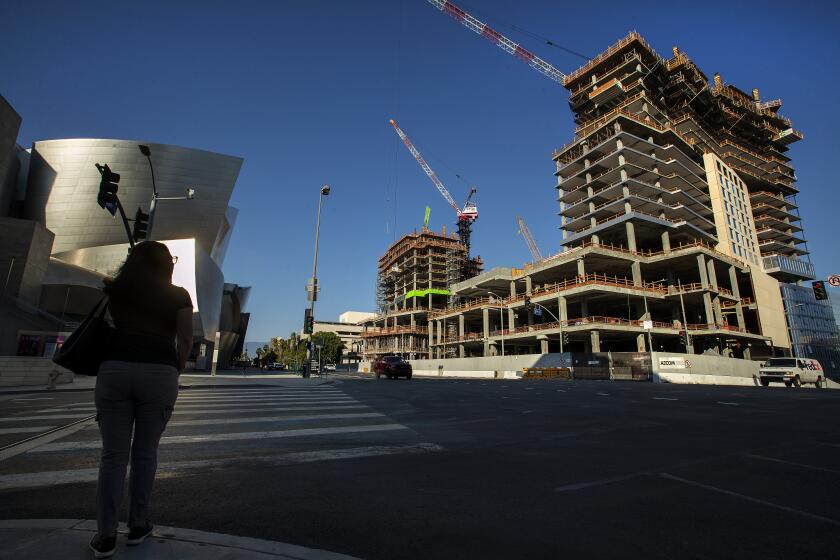He’s working on L.A.’s next great skyscraper, Angels Landing.
- Share via
Real estate developer Ricardo Pagan has made his mark in New York City and Detroit, but the biggest project of his career aims to change the skyline of downtown L.A.
Pagan, 39, is founder and chief executive of Claridge Properties, one of three developers tasked with erecting the Angels Landing project — a $1.5-billion development that will bring two skyscrapers to the Bunker Hill neighborhood near the historic Angels Flight railway. All of the developers — Peebles Corp. and MacFarlane Partners are the other two — are owned by people of color.
For the record:
6:15 p.m. April 9, 2021
A previous version of this article said a school is planned, but representatives of Angels Landing Partners said a school is not currently part of the official plan. In addition, a previous version of this article said the larger of the two buildings would be 1,000 feet tall; the representatives said the building will be 854 feet tall.
Angels Landing has been touted as a mini neighborhood. The vision for the ambitious project includes affordable as well as market-rate apartments, plus condos, shops, restaurants, two hotels, a park and perhaps even an elementary school, if Pagan’s efforts come to fruition. Representatives for Angels Landing Partners said the school isn’t currently part of the official plan.
Pagan said the taller of the two buildings would reach 1,000 feet, which would make it one of the tallest buildings west of the Mississippi River. The representatives said the tallest building is now planned to be 854 feet.
Construction will take about four years to complete and is planned to begin in 2022 or 2023. The project is currently in the entitlement phase, and Pagan expects all approvals will be granted by the end of the year.
For Pagan, who emigrated from the Dominican Republic as a teenager in the early 1990s, the project is personal.
Pagan said he’s acutely aware that he wouldn’t be in his position if not for the opportunities given to him by others, and he’s hoping to return the favor by opening doors for those who would otherwise not be involved. He and his partners have vowed that 30% of the project’s contracts will go to minority- and women-owned businesses, a goal that set the team’s bid apart during a yearlong competition with 10 other firms.
Pagan sat down with The Times to discuss the Angels Landing project and his philosophies as a developer. The interview has been edited and condensed for clarity and space.
Could the pandemic potentially kill this project?
No. The likelihood of this project not happening is zero. Will we get delayed? Maybe. Will we go over budget? Maybe. But the pandemic has brought financial pressure to this city, so this project is more important than ever. This process started in 2013, and it’s like any other. It’s massive, it’s bureaucratic, but we’re committed, and we’re going to see it through. The current effects of the pandemic are temporary, and there are many years of continued growth for downtown L.A. and the Southern California region as a whole. Angels Landing will be the beacon of that resurgence.
Downtown markets have obviously taken a hit over the last year, and it seems like people are more hesitant about vertical living because of the pandemic. Is that a concern?
Our project is nearly six years away from completion. In market terms, that’s a very long time, and many things will change. The pandemic has definitely put pressure on downtown L.A., but the same was the case when Sept. 11 occurred in downtown Manhattan; it was sworn, back in those days, that downtown would never revive itself, but less than six years later, that area was completely revitalized. The same will occur here. Even though the economic story of downtown L.A. and downtown Manhattan aren’t exactly the same, the forces guiding it are. Keep in mind that over 500,000 employees that used to flood the streets of downtown L.A. are currently stuck at home, and as the pandemic calms down, those people will be returning to downtown. People will always gravitate to their urban cores.
In a downtown missing its office workers, tourists and museum visitors, work on the Frank Gehry-designed $1-billion Grand complex reaches the halfway point.
What’s your role?
I’m a co-developer alongside Peebles Corp. and MacFarlane Partners. From the start, we’ve acted as the local team on the ground here in L.A. given our presence and relationships — relationships that allowed us as a team to procure the winning bid for the project. We work with politicians to make sure it gets there on time and within the budget.
After projects in New York and Detroit, what brought you to L.A.?
When I visited L.A. in 2011, I realized two things: It has a huge market, but it’s extremely underdeveloped compared to cities like New York City, Boston and San Francisco. Downtown L.A. is one of the least developed downtown areas in the U.S.; it’s like Detroit from a development standpoint but New York City in scale. I wanted to plant my flag somewhere, so I decided to put my focus here and create a 24/7 entertainment experience as many major cities already had.
What’s your vision for downtown L.A.?
When I got here, downtown L.A. was a development desert except for L.A. Live. I consider myself a visionary, and we have to envision the future of the urban markets we impact. With the right projects, I knew the city could be more prevalent with better schools, cleaner streets, affordable housing and everything that goes along with it. Overall, downtown L.A. will be an oasis based on the projects coming in as soon as people feel safe enough to invest their money here.
Your company plans for Angels Landing to bring 180 condos, 261 apartments and 800 permanent jobs through the building’s hotel and retail outlets. And you’re hoping to add a school?
For me, the school is the biggest part of the project. Downtown L.A. doesn’t have many educational facilities to serve its growing population of young and existing families that are and will reside here. We want young families to consider living downtown, but right now, they don’t. As of now, the plan is for an elementary charter school for grades K-5. It’ll serve roughly 450 kids and be open to all — but preference will be given to those residing downtown. We’re working with the L.A. Academy of Arts & Enterprise to develop it.
What’s your motivation for earmarking 30% of the contracts for businesses owned by minorities and women?
Projects of this scale are usually built by multinational conglomerates, the usual suspects. You don’t see guys like us building and shepherding these projects, and if we have this opportunity, we need to give it to someone else. My entire executive team and everyone on my staff is a minority, and economic diversity is the biggest driver behind what I do. It’s a mandate we put across the board from top to bottom, for architects, consultants, attorneys and designers to give people like us an opportunity to grow in a business that isn’t always open to minorities. If someone didn’t give me a chance to enter into these worlds in New York City in 2000 and Detroit in 2006, I wouldn’t be talking to you right now.
The developer’s crypto embrace includes accepting bitcoin rent payments at the Grove and Americana, part of a venture with the Winklevoss twins.
You started your career working on houses and apartment complexes, and now you’re working on skyscrapers. What’s the difference?
Ever since real estate caught my eye in the 1990s in New York, I always had a love for skyscrapers. There’s a lot more people involved, but it’s the same work for more money and more impact. When you buy or sell a house, it impacts one family. When you build a skyscraper, not only can you provide affordable housing, you also impact the economy. I’d rather work on larger-scale projects and have a greater impact. I’m willing to go to the casino, put my chips down and let it be. You need a thick skin to be a developer, and the way I got here was by not allowing fear to preclude me from big opportunities like this.
What do you want your impact to be?
I don’t want to be the guy who went into downtown L.A. and gentrified it and created a market that not everyone can enjoy. We’re bringing not only affordable housing but also the amenities for those families to enjoy, from our educational facilities to our open-air park and our retail offerings. We aren’t just building a luxury product as many other projects downtown clearly have. I’m for the people at the bottom. I want to get this done not just for the investors but for the families, workers and unions. I’d like my impact to bridge the equality gap and bring equal opportunity to those involved and create a blueprint and legacy for other minorities.
More to Read
Sign up for Essential California
The most important California stories and recommendations in your inbox every morning.
You may occasionally receive promotional content from the Los Angeles Times.









